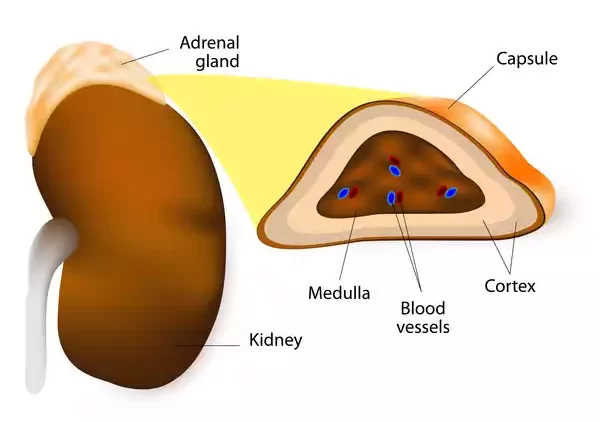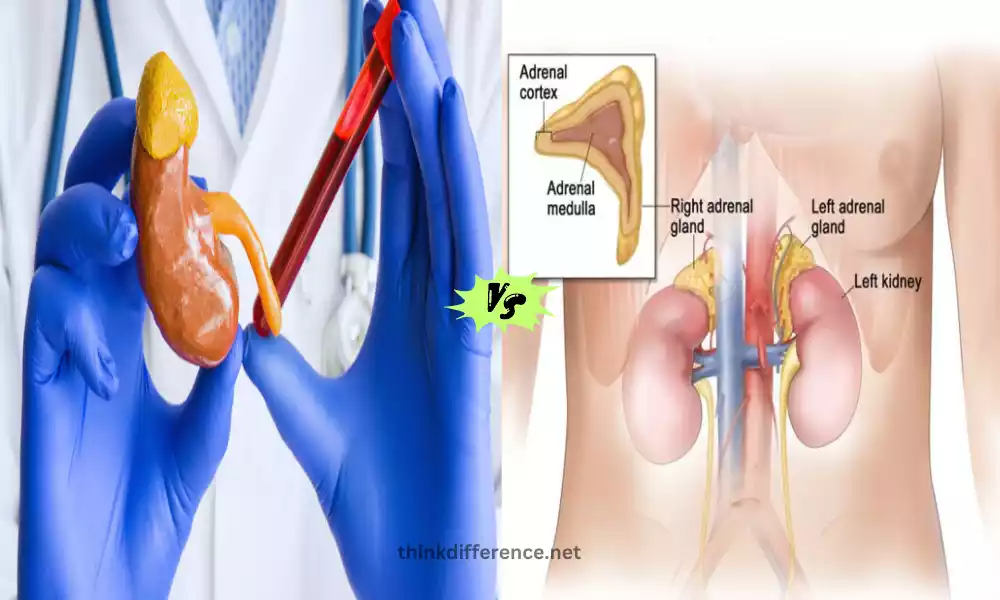Congenital Adrenal Hyperplasia and Hypoplasia are complex medical conditions that affect the adrenal glands from birth. These conditions involve abnormalities in hormone production and adrenal gland development, leading to various health challenges.
Congenital Adrenal Hyperplasia involves an overproduction of certain hormones due to enzyme deficiencies, while Congenital Adrenal Hypoplasia is characterized by underdeveloped adrenal glands and hormone deficiencies. These conditions can have significant impacts on an individual’s overall well-being and require careful medical management.
What is Congenital Adrenal Hyperplasia?

Congenital Adrenal Hyperplasia (CAH) is a group of genetic disorders that affect the adrenal glands, which are responsible for producing various hormones essential for the body’s functioning. CAH specifically involves a deficiency in one of the enzymes required for the production of cortisol, a stress hormone, and sometimes aldosterone, a hormone that helps regulate salt and water balance.
The most common form of CAH is caused by a deficiency in the enzyme 21-hydroxylase, which leads to a disruption in the production of cortisol and aldosterone. As a result, the body produces higher levels of androgens (male sex hormones). This can lead to a range of symptoms and health issues, including ambiguous genitalia in female infants, early appearance of pubic hair and rapid growth in both sexes, and potential fertility problems later in life.
Early diagnosis and medical management are important to prevent complications and ensure proper growth and development. Treatment often involves hormone replacement therapy to replace the missing cortisol and, if necessary, aldosterone. It’s important to work closely with healthcare professionals to manage CAH effectively.
Types of Congenital Adrenal Hyperplasia
There are several types of Congenital Adrenal Hyperplasia (CAH), each caused by a deficiency in a specific enzyme involved in the production of cortisol and other hormones. Here are the main types of CAH:
- 21-Hydroxylase Deficiency (Classic CAH): This is the most common form of CAH, accounting for about 95% of cases. It’s further divided into two subtypes: the salt-wasting form and the simple-virilizing form. Both types lead to varying degrees of cortisol and aldosterone deficiency, resulting in elevated androgen levels and potential masculinization of external genitalia in females.
- 11-Beta Hydroxylase Deficiency: This type of CAH leads to excess production of androgens and cortisol precursors, causing symptoms such as virilization (masculinization) in females and precocious puberty in both sexes.
- 17-Hydroxylase Deficiency: This rare form of CAH results in decreased production of cortisol and sex steroids, leading to a lack of sexual development during puberty and high blood pressure due to the loss of aldosterone.
- 3-Beta Hydroxysteroid Dehydrogenase Deficiency: This is a rare form of CAH that affects multiple steroid hormones, leading to symptoms such as ambiguous genitalia in females and impaired sexual development in males.
- Lipoid CAH (StAR Deficiency): This extremely rare form is caused by a deficiency in a protein called StAR, which is necessary for transporting cholesterol into the mitochondria for steroid hormone production. It leads to a severe deficiency in all adrenal and gonadal steroid hormones and can be life-threatening.
It’s important to note that CAH is a complex condition, and its severity and symptoms can vary widely. Early diagnosis and appropriate medical management are crucial to ensure the best possible outcomes for individuals with CAH. If you have specific questions about CAH or its management within the context of the Pods plugin, feel free to ask.
Symptoms of Adrenal Hyperplasia
Here are the symptoms of Congenital Adrenal Hyperplasia (CAH) presented:
- Genital Abnormalities: Ambiguous genitalia in females at birth due to excess androgens during fetal development.
- Rapid Growth: Children with CAH may experience accelerated growth and skeletal maturation.
- Early Puberty: Children may develop pubic hair, acne, and other signs of puberty earlier than expected.
- Salt-Wasting Crisis: In severe cases, infants can experience life-threatening salt-wasting crises with vomiting, dehydration, and low sodium levels.
- Hormonal Imbalances: Elevated androgen levels can lead to menstrual irregularities, excessive body hair, and masculine features in females.
- Fertility Issues: CAH can impact fertility and menstrual regularity in affected individuals.
- Adrenal Crisis: Stress or illness can trigger adrenal crisis due to the body’s inability to produce enough cortisol, leading to weakness, vomiting, low blood sugar, and shock.
It’s important to note that the severity and specific symptoms of CAH can vary depending on the type and degree of enzyme deficiency. Early diagnosis and medical management are crucial to prevent complications and ensure proper growth and development.
If you have further questions or need assistance in organizing or presenting information about the symptoms of Adrenal Hyperplasia using the Pods plugin in WordPress, feel free to ask.
What is Congenital Adrenal Hypoplasia?

Congenital Adrenal Hypoplasia (CAH) is a rare genetic disorder that affects the development and function of the adrenal glands. Unlike Congenital Adrenal Hyperplasia (CAH), which involves an overgrowth of adrenal tissue, CAH is characterized by the underdevelopment (hypoplasia) of the adrenal glands. This condition leads to a deficiency in the production of cortisol and, in some cases, aldosterone.
CAH can result from mutations in the DAX1 gene, which is located on the X chromosome. This gene is crucial for the normal development and functioning of the adrenal glands and other endocrine tissues. When DAX1 gene mutations are present, they can disrupt the growth of the adrenal glands and impair the production of cortisol, leading to a range of symptoms.
The symptoms of CAH can vary depending on the severity of adrenal gland underdevelopment and hormone deficiency. Newborns with CAH may present with salt-wasting, which can lead to dehydration, low blood pressure, and other serious complications. Additionally, individuals with CAH may experience delayed puberty, growth issues, and various hormonal imbalances due to the lack of cortisol and sometimes aldosterone.
Management of CAH typically involves hormone replacement therapy to address the cortisol and aldosterone deficiencies. Close medical supervision and care are essential to ensure appropriate growth, development, and overall well-being for individuals with Congenital Adrenal Hypoplasia.
If you have further questions or if you’d like to discuss how to manage information related to Congenital Adrenal Hypoplasia using the Pods plugin in WordPress, please feel free to ask.
Causes of Adrenal Hypoplasia
Here are the causes of Adrenal Hypoplasia presented:
- Genetic Mutations: Adrenal Hypoplasia is primarily caused by mutations in the DAX1 gene.
- DAX1 Gene: Mutations in the DAX1 gene disrupt adrenal gland development and hormone production.
- X-Linked Recessive: The condition is often inherited in an X-linked recessive manner, more common in males.
- Adrenal Gland Underdevelopment: Genetic mutations lead to the underdevelopment (hypoplasia) of the adrenal glands.
- Cortisol Deficiency: Adrenal Hypoplasia results in a lack of cortisol production.
- Aldosterone Imbalance: In some cases, aldosterone production may also be affected.
- Symptoms: Genetic mutations can cause symptoms like delayed puberty, growth issues, and hormonal imbalances.
If you have more specific questions or if you’d like to know how to manage this information using the Pods plugin in WordPress, feel free to ask.
Symptoms of Adrenal Hypoplasia
Here are the symptoms of Congenital Adrenal Hypoplasia (CAH) presented:
- Cortisol Deficiency: The underdeveloped adrenal glands result in insufficient cortisol production.
- Aldosterone Imbalance: Some cases may lead to reduced aldosterone production, affecting salt and water balance.
- Salt-Wasting Crisis: Infants may experience dehydration and low sodium levels, leading to vomiting, weakness, and low blood pressure.
- Delayed Puberty: Hormonal imbalances can cause delayed or incomplete puberty.
- Growth Issues: Children may experience slower growth and skeletal development.
- Hypoglycemia: Low cortisol levels can result in low blood sugar levels.
- Fatigue and Weakness: Cortisol deficiency can lead to fatigue, weakness, and decreased stress tolerance.
The symptoms can vary based on the severity of adrenal gland underdevelopment and hormone deficiencies. Management typically involves hormone replacement therapy to address cortisol and aldosterone deficiencies. If you need assistance in organizing or presenting information about the symptoms of Adrenal Hypoplasia using the Pods plugin in WordPress, feel free to ask.
Impact on Hormone Production
The impact of Adrenal Hypoplasia on hormone production is significant and can lead to various hormonal imbalances due to the underdevelopment of the adrenal glands and the resulting deficiency in cortisol and, potentially, aldosterone. Here’s how it affects hormone production:
- Cortisol Deficiency: The adrenal glands play a crucial role in producing cortisol, a hormone that helps the body respond to stress, regulate metabolism, and maintain blood pressure. In Adrenal Hypoplasia, the underdeveloped adrenal glands struggle to produce sufficient cortisol, leading to cortisol deficiency.
- Aldosterone Imbalance: In some cases of Adrenal Hypoplasia, aldosterone production may also be affected. Aldosterone is important for regulating the balance of salt and water in the body and maintaining blood pressure. Its deficiency can lead to electrolyte imbalances and low blood pressure.
- Androgen Levels: While not as pronounced as in conditions like Congenital Adrenal Hyperplasia (CAH), some individuals with Adrenal Hypoplasia might experience mild elevations in androgen levels. Androgens are male sex hormones that are present in both males and females and play a role in sexual development and other bodily functions.
- Feedback Loops: Hormonal imbalances in Adrenal Hypoplasia can disrupt the normal feedback loops that regulate hormone production in the body. This can further impact the functioning of the hypothalamus-pituitary-adrenal (HPA) axis, which controls the release of cortisol and other hormones.
- Puberty and Growth: Hormonal imbalances resulting from Adrenal Hypoplasia can lead to delayed or incomplete puberty, growth issues, and development of secondary sexual characteristics.
Management of Adrenal Hypoplasia typically involves hormone replacement therapy to address the deficiencies in cortisol and, if necessary, aldosterone. Regular monitoring and medical care are essential to ensure proper hormone levels and overall health.
If you have specific questions about managing or presenting information about the impact of Adrenal Hypoplasia on hormone production using the Pods plugin in WordPress, feel free to ask for guidance.
Diagnosis of Adrenal Hyperplasia and Adrenal Hypoplasia

Diagnosing both Congenital Adrenal Hyperplasia (CAH) and Congenital Adrenal Hypoplasia involves a combination of clinical evaluation, hormone level testing, genetic analysis, and sometimes imaging. Here’s a general overview of the diagnostic process for both conditions:
Diagnosis of Congenital Adrenal Hyperplasia (CAH):
- Clinical Assessment: A thorough physical examination is conducted to assess for signs of ambiguous genitalia (in females), rapid growth, early appearance of pubic hair, and other physical manifestations of CAH.
- Hormone Level Testing: Blood tests are performed to measure hormone levels, especially 17-hydroxyprogesterone and other androgen-related hormones. Elevated levels of these hormones, along with other hormonal imbalances, can suggest the presence of CAH.
- Genetic Testing: Genetic testing is often used to confirm the diagnosis and identify mutations in genes associated with CAH, particularly the CYP21A2 gene for 21-hydroxylase deficiency.
- ACTH Stimulation Test: This test measures the adrenal glands’ response to synthetic ACTH hormone, helping to assess their functionality and cortisol production.
- Imaging: CAH with salt-wasting crises, imaging techniques like ultrasound may be used to assess the adrenal glands’ size and structure.
Diagnosis of Congenital Adrenal Hypoplasia (CAH):
- Clinical Evaluation: A thorough physical examination is performed to assess for signs of cortisol and aldosterone deficiency, delayed puberty, and other manifestations of adrenal hypoplasia.
- Hormone Level Testing: Blood tests are conducted to measure cortisol and aldosterone levels. Low levels of these hormones, along with elevated ACTH, can indicate adrenal hypoplasia.
- Genetic Testing: Genetic testing may be used to confirm the diagnosis and identify mutations in genes associated with adrenal hypoplasia, particularly the DAX1 gene.
- ACTH Stimulation Test: Similar to CAH, this test can assess the adrenal glands’ response to synthetic ACTH, helping to evaluate their functionality.
- Imaging: Imaging techniques like ultrasound or MRI may be employed to assess the size and structure of the adrenal glands.
Early and accurate diagnosis of both conditions is crucial for appropriate treatment and management. Hormone replacement therapy is often used to address hormonal deficiencies. Regular medical monitoring is important to ensure proper growth, development, and overall well-being for individuals with these conditions.
If you’re looking to manage information related to the diagnosis of Adrenal Hyperplasia and Adrenal Hypoplasia using the Pods plugin in WordPress, feel free to ask for guidance on how to set up custom fields or taxonomies to organize and present this information effectively.
Treatment Approach for Adrenal Hyperplasia and Adrenal Hypoplasia
The treatment approaches for Congenital Adrenal Hyperplasia (CAH) and Congenital Adrenal Hypoplasia differ due to the distinct underlying causes of these conditions. Here’s an overview of the treatment approaches for both:
Treatment Approach for Congenital Adrenal Hyperplasia (CAH)
The primary goal of treatment for CAH is to normalize hormone levels, prevent complications, and ensure optimal growth and development. The specific treatment plan depends on the type and severity of CAH:
- Hormone Replacement Therapy: Individuals with CAH, particularly the salt-wasting form, require cortisol replacement therapy to maintain normal cortisol levels. This therapy helps prevent adrenal crises and provides the body with the necessary cortisol for stress response.
- Mineralocorticoid Replacement: In some cases, aldosterone replacement therapy may be needed to address salt and water imbalances. This is especially important for individuals with the salt-wasting form of CAH.
- Androgen Suppression: Depending on the severity of the condition and the type of CAH, additional medications may be used to suppress the excess androgens responsible for virilization. These medications can help manage symptoms related to androgen excess.
- Surgical Interventions: Where genital ambiguity is present, surgical interventions might be considered to correct genital anatomy in females.
- Lifelong Medical Care: Regular monitoring by a medical team, including endocrinologists and pediatric specialists, is essential to adjust hormone dosages as needed and ensure optimal growth and development.
Treatment Approach for Congenital Adrenal Hypoplasia (CAH)
The treatment approach for adrenal hypoplasia focuses on providing hormone replacement therapy to address cortisol and, if necessary, aldosterone deficiencies:
- Cortisol Replacement: Hormone replacement therapy is crucial to provide the body with the necessary cortisol levels. This helps manage symptoms associated with cortisol deficiency, such as fatigue, weakness, and hypoglycemia.
- Aldosterone Replacement: If aldosterone deficiency is present, aldosterone replacement therapy may be needed to manage salt and water balance and prevent electrolyte imbalances.
- Lifelong Medical Care: Regular monitoring and medical supervision are important to adjust hormone dosages based on growth and development and to ensure overall health.
Both CAH and adrenal hypoplasia require careful management and close medical monitoring. Treatment plans are tailored to each individual’s needs, and ongoing collaboration with a medical team is essential to achieve the best outcomes.
If you’re interested in managing information related to the treatment approaches for Adrenal Hyperplasia and Adrenal Hypoplasia using the Pods plugin in WordPress, feel free to ask for guidance on setting up custom fields or taxonomies to organize and present this information effectively.
Comparison table of Adrenal Hyperplasia and Adrenal Hypoplasia
Here’s a comparison table outlining the key differences between Congenital Adrenal Hyperplasia (CAH) and Congenital Adrenal Hypoplasia:
| Aspect | Congenital Adrenal Hyperplasia (CAH) | Congenital Adrenal Hypoplasia |
|---|---|---|
| Underlying Cause | Enzyme deficiencies (e.g., 21-hydroxylase) leading to excess androgen production | Genetic mutations (e.g., DAX1 gene) leading to underdeveloped adrenal glands and cortisol deficiency |
| Hormone Imbalances | Excess androgen production (androstenedione, testosterone) | Cortisol and potentially aldosterone deficiency |
| Typical Presentation | Ambiguous genitalia in females, early appearance of pubic hair, rapid growth | Delayed puberty, growth issues, hypoglycemia, weakness |
| Newborn Presentation | Salt-wasting crisis, dehydration, low sodium levels | Less commonly associated with severe salt-wasting |
| Impact on Sexual Development | Virilization (masculinization) of female genitalia and secondary sexual characteristics | Delayed puberty, incomplete development of secondary sexual characteristics |
| Treatment Approach | Hormone replacement therapy (cortisol) to manage androgen excess | Hormone replacement therapy (cortisol, aldosterone) to address deficiencies |
| Potential Complications | Excess androgen-related complications (e.g., fertility issues) | Electrolyte imbalances, delayed growth, and other cortisol-related complications |
| Genetic Basis | Autosomal recessive (in most cases) | X-linked recessive (in most cases) |
| Genetic Mutations | Often involves mutations in genes related to steroidogenesis enzymes | Often involves mutations in the DAX1 gene |
| Fertility Impact | Potential fertility challenges due to androgen excess | Potential fertility challenges due to cortisol and aldosterone deficiencies |
| Associated Conditions | Potential for other hormonal imbalances | Potential for delayed puberty, hypoglycemia, and weakness |
| Surgical Interventions (Females) | May involve surgery to correct genital ambiguity | No specific surgical interventions typically required |
The severity and presentation of both conditions can vary widely based on the specific genetic mutations and individual factors. This table provides a general comparison and overview of the two conditions. If you have more specific questions or need further assistance, feel free to ask.
Similarities of Congenital Adrenal Hyperplasia and Hypoplasia
Here are the similarities between Congenital Adrenal Hyperplasia (CAH) and Congenital Adrenal Hypoplasia:
- Genetic Basis: Both conditions are caused by genetic factors, either enzyme deficiencies (CAH) or mutations in specific genes (adrenal hypoplasia).
- Adrenal Gland Impact: Both conditions affect the adrenal glands’ function, leading to hormonal imbalances.
- Hormone Disruption: Both conditions disrupt normal hormone production, leading to various symptoms and health challenges.
- Health Impact: Both conditions can result in physical and developmental challenges that require medical management.
- Early Diagnosis: Early diagnosis is crucial for both conditions to initiate appropriate treatment and prevent complications.
- Individualized Care: Both conditions require personalized treatment plans tailored to the individual’s needs.
- Hormone Replacement: Treatment for both conditions often involves hormone replacement therapy to restore hormonal balance.
- Medical Monitoring: Ongoing medical monitoring is necessary for individuals with both conditions to ensure optimal health.
These similarities underline the importance of accurate diagnosis, tailored treatment, and continuous medical care for individuals affected by these adrenal disorders.
Research and Advancements
Research and advancements in the field of adrenal disorders, including Congenital Adrenal Hyperplasia (CAH) and Congenital Adrenal Hypoplasia, continue to contribute to improved diagnosis, treatment, and understanding of these conditions.
Below are a few noteworthy areas of study and research:
Genetic Studies: Advances in genetic sequencing and analysis have allowed researchers to identify specific gene mutations associated with adrenal disorders. This has led to more accurate diagnosis, better understanding of disease mechanisms, and potential targets for therapies.
New Therapies: Researchers are exploring novel therapeutic approaches, such as gene therapy and gene editing techniques, to address the underlying genetic mutations causing adrenal disorders. These approaches hold the promise of correcting genetic defects and restoring normal hormone production.
Precision Medicine: Research is focusing on personalized treatment plans based on an individual’s genetic makeup, severity of the condition, and other factors. This approach aims to optimize hormone replacement therapy and minimize potential side effects.
Hormone Management: Advances in hormone replacement therapies aim to improve the delivery and effectiveness of cortisol and aldosterone replacement, enhancing the overall well-being of individuals with adrenal disorders.
Fertility and Reproductive Health: Research is ongoing to understand the impact of adrenal disorders on fertility, pregnancy, and reproductive health. This includes exploring strategies to optimize fertility outcomes for affected individuals.
Long-Term Outcomes: Studies are investigating the long-term health outcomes and quality of life for individuals with adrenal disorders. This research helps guide treatment approaches and support for patients throughout their lives.
Patient Education and Support: Advances in technology have enabled the development of online resources, support groups, and educational materials for patients and their families, fostering a better understanding of adrenal disorders and the available treatment options.
Collaborative Research: Collaborative efforts between clinicians, researchers, and patient advocacy groups have accelerated the pace of discovery and translated research findings into improved patient care.
It’s important to stay updated on the latest research findings and advancements, especially if you or someone you know is affected by adrenal disorders. Always consult with medical professionals for the most current and accurate information regarding diagnosis, treatment, and management.
If you’re interested in managing information related to research and advancements in the field of adrenal disorders using the Pods plugin in WordPress, feel free to ask for guidance on how to organize and present this information effectively.
Summary
Congenital Adrenal Hyperplasia (CAH) involves excess androgen production due to enzyme deficiencies, often leading to ambiguous genitalia and early puberty. Congenital Adrenal Hypoplasia, on the other hand, stems from genetic mutations causing underdeveloped adrenal glands and cortisol deficiency, resulting in delayed puberty and growth issues. Tailored hormone replacement therapies play a key role in managing these conditions, emphasizing the importance of early diagnosis and personalized medical care.



